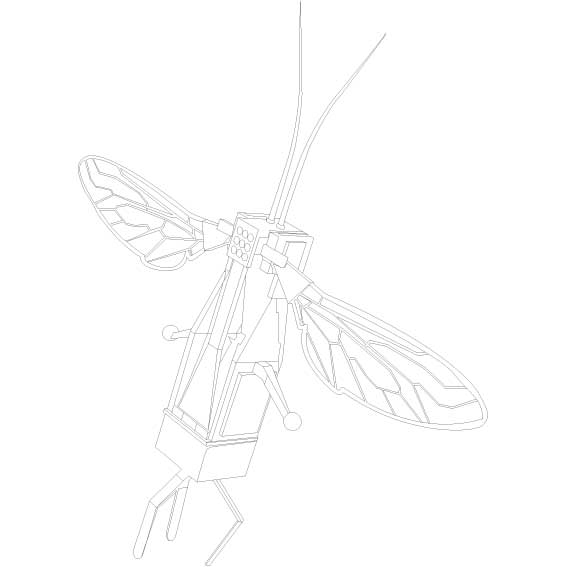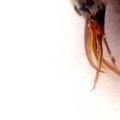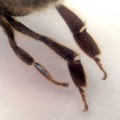A honeycomb is a mass of hexagonal wax cells built by honey bees in their nests to contain their larvae and stores of honey and pollen.
The axes of honeycomb cells are always quasi-horizontal, and the nonangled rows of honeycomb cells are always horizontally (not vertically) aligned. Thus, each cell has two vertical walls, with “floors” and “ceilings” composed of two angled walls. The cells slope slightly upwards, between 9 and 14 degrees, towards the open ends. The hexagon tiles the plane with minimal surface area. Thus, a hexagonal structure uses the least material to create a lattice of cells within a given volume.
Another explanation is that the shape simply results from the process of individual bees putting cells together: somewhat analogous to the boundary shapes created in a field of soap bubbles. In support of this, he notes that queen cells, which are constructed singly, are irregular and lumpy with no apparent attempt at efficiency.
The closed ends of the honeycomb cells are also an example of geometric efficiency, albeit three-dimensional and little-noticed. The ends are trihedral (i.e., composed of three planes) sections of rhombic dodecahedra, with the dihedral angles of all adjacent surfaces measuring 120°, the angle that minimizes surface area for a given volume. The shape of the cells is such that two opposing honeycomb layers nest into each other, with each facet of the closed ends being shared by opposing cells.
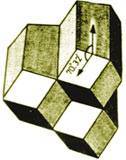
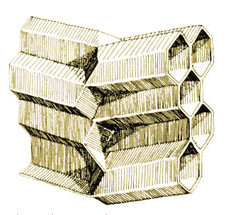

The hive is a system of homeostasis. Homeostasis is the property of a system that regulates its internal environment and tends to maintain a stable, constant condition of properties like temperature or pH. It can be either an open or closed system.
A medium sized nest needs 1200gr wax to be build, and 7,5 kg honey for the energy. Beeswax is composed of more than 300 different chemical components.
The vertical comb construction is parallel to the earth magnetic field, the bees can construct this way thanks to the gravity receptors (organs) that are situated in all their legs and body joints.
The bees’ body is the basic template for the construction of a wax cell. From a cylindrical form the cells become hexagonal under the tension of the regurlarly constructed comb and heated by the bees’ bodyheath (cfr. soap bubbles joining together). The wax wall of a cell is 0,07mm. The antennae of the bees measure the cells’ thickness.
The comb + wax is an integral and inseparable part of the colony as superorganism.
The comb is =>
Living space
Food storage
Nursery
A skeleton
A sensory organ
A nervous system
A memory stare
An immune system
Functions of the comb =>
Telephone system
Information storage
Colony specific identity
Defense against pathogens
Shelter
Nursery (center)
Storage & production ⇒ periphery
The nectar/honey is mixed with antibacterial and antifungal peptides and enzymes, before storage in the cells
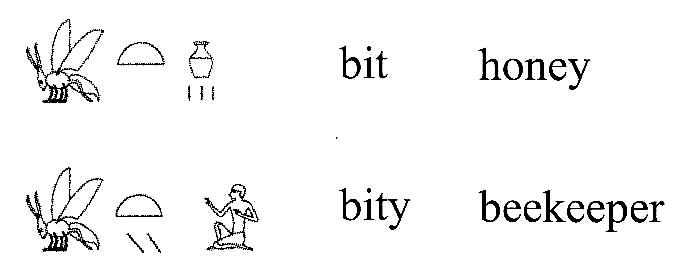
Bees were very important in the daily life of ancient Egypt. The bee was an insignia of kingship associated particularly with Lower Egypt, where there may even have been a Bee King in pre-dynastic times. The bee was considered sacred by early Egyptians and often regarded as a symbol of resurrection. In Egyptian mythology the Sun God Ra created the honey bee from his tears. The bee, representing the word bit – meaning bee or honey in hieroglyphics, was used as a prefix to the throne name of Egyptian rulers. Bee stood for He of the Bee or King of Lower Egypt.
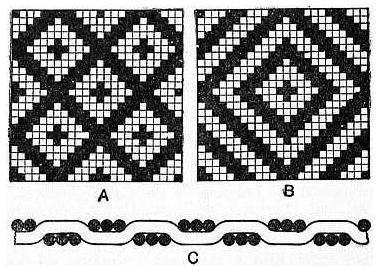
Diaper is the name given to a textile fabric, formerly of a rich and costly nature with embroidered ornament, but now of linen or cotton, with a simple woven pattern; and particularly restricted to small napkins. In architecture, the term “diaper” is given to any small pattern of a conventional nature repeated continuously and uniformly over a surface; the designs may be purely geometrical, or based on floral forms, and in early examples were regulated by the process of their textile origin. Subsequently, similar patterns were employed in the middle ages for the surface decoration of stone, as in Westminster Abbey and Bayeux cathedral in the spandrils of the arcades of the choir and nave; also in mural painting, stained glass, incised brasses, encaustic tiles, &c. Probably in most cases the pattern was copied, so far as the general design is concerned, from the tissues and stuffs of Byzantine manufacture, which came over to Europe and were highly prized as ecclesiastical vestments.
